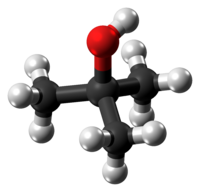
Photo from wikipedia
The etherification of glycerol with tert-butyl alcohol in the presence of acid catalysts gives rise to the production of ethers (monoethers, diethers and triethers) of high added-value, which can be… Click to show full abstract
The etherification of glycerol with tert-butyl alcohol in the presence of acid catalysts gives rise to the production of ethers (monoethers, diethers and triethers) of high added-value, which can be used as oxygenated additives in fuels. This reaction is limited by the thermodynamic equilibrium, which can be modified by the addition of solvents that selectively solubilize the products of interest along with tert-butyl alcohol, leading to the progress of the reaction. In this work, it has been demonstrated that the addition of dibutyl ether allows shifting the reaction equilibrium, increasing the production of diethers. From the study of the main operating conditions, it was determined that an increase in the concentration of the solvent has a positive effect on the selectivity towards the production of diethers, the concentration of the catalyst (a commercial ion exchange resin, Amberlyst 15, named A-15) and the reaction temperature were also determining variables. Working with concentrations of tert-butyl alcohol above the stoichiometric one did not report great advantages. The optimal operating conditions to maximize the conversion of glycerol and the selectivity towards diethers were: 70 °C, 20% catalyst (referred to the total starting mass of the system), the stoichiometric ratio of glycerol:tert-butyl alcohol (G:TB = 1:3) and 1:2 molar ratio of dibutyl ether:tert-butyl alcohol. A study of three consecutive reaction cycles showed the high stability of the catalyst, obtaining identical results.
Journal Title: Catalysts
Year Published: 2019
Link to full text (if available)
Share on Social Media: Sign Up to like & get
recommendations!